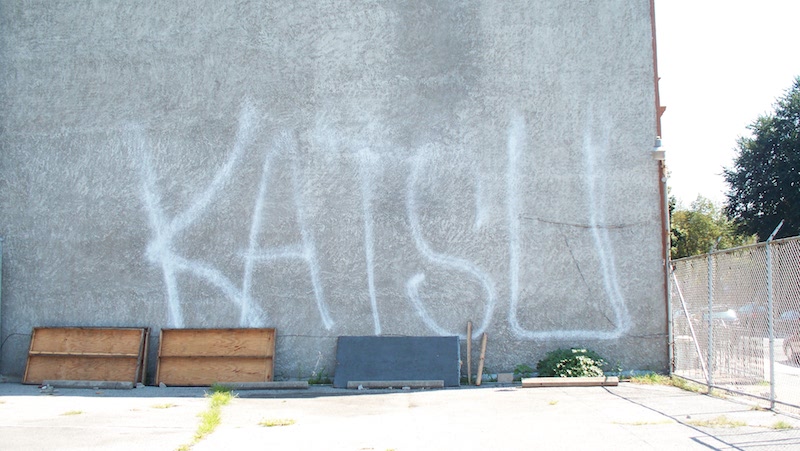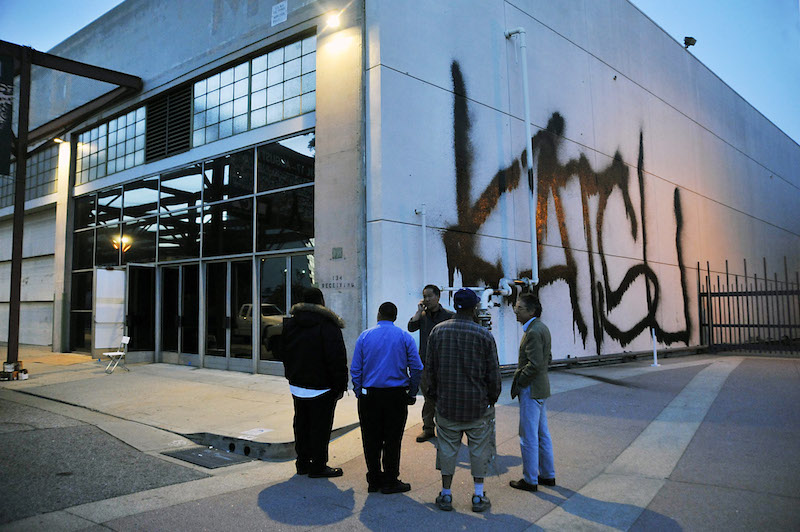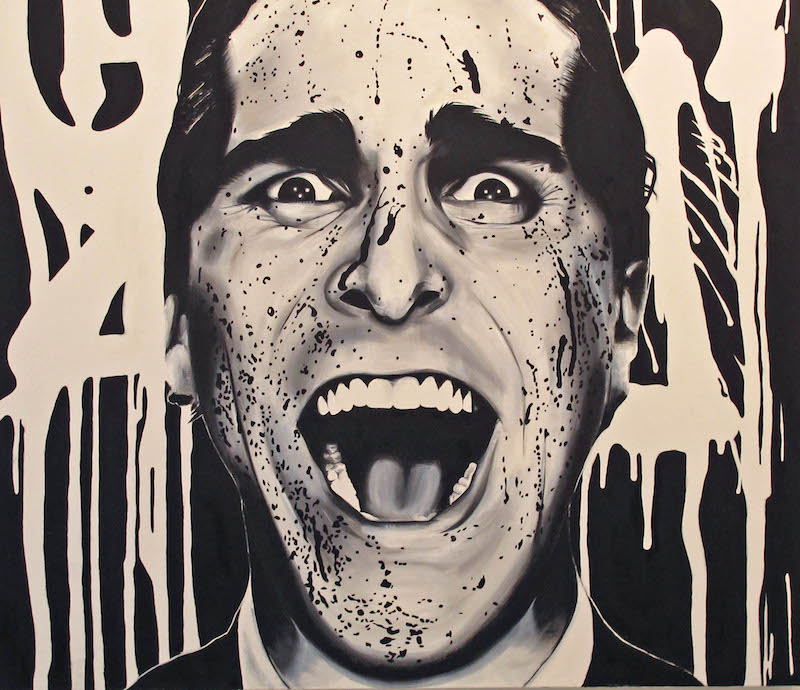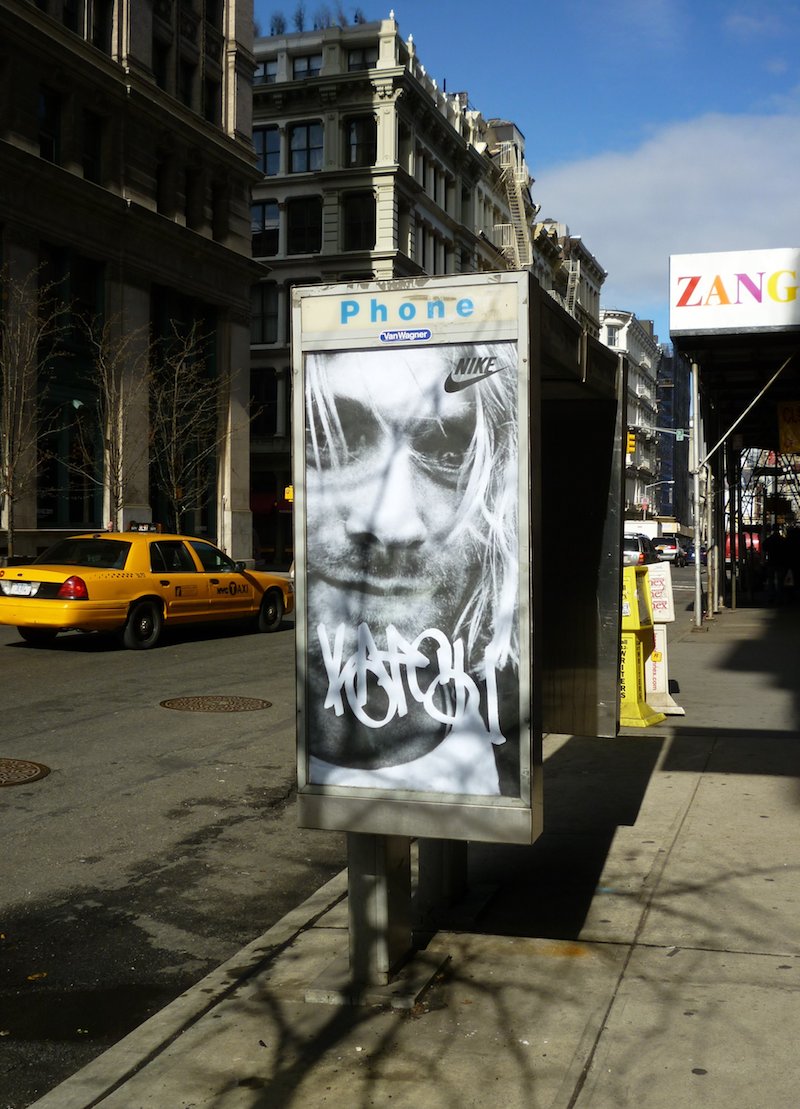
KATSU in Brooklyn. Photo by Mr. Harrington.
KATSU is one of contemporary graffiti’s most interesting writers as well as a Virtual Research Fellow at F.A.T. Lab. As a member of the BTM Crew, he is a world-class writer when it comes to traditional graffiti on the street. Be it with stickers, markers, posters, spraypaint or even fire extinguishers filled with paint, KATSU has gotten up hard for years. But what really sets KATSU apart for me and for the purposes of this book are his experiments with digital graffiti. KATSU is a master of getting his brand in your head, by any means necessary. KATSU still retains some of that traditional graffiti viewpoint about the preeminence of physical work, but his thoughts and deeds regarding digital graffiti are miles beyond almost any street artist or other graffiti writer. Although KATSU is usually quite secretive, I was lucky enough to get this email interview with him.
RJ: How do you use the internet in relation to your artwork?
KATSU: I use the internet as an intimate media outlet for people of the graffiti demographic to learn about me. The internet is the medium. The internet is explored, logged and shared. Half of what I do is based on what type of reaction my experiments get. The internet is the ultimate testing ground for my visual works.
RJ: How did you come up with the idea to make work for an entirely online audience and why make that decision?
KATSU: I took a look in the mirror and accepted that I did everything online. I looked at art, crime, news and stories all online. I couldn’t lie to myself and say, “The internet is bullshit, everything is fake and not substantial.” There was no question as to whether the internet was the best way to accumulate “FT’s”. But something I noticed was that the internet had a weird way of credentialing happenings. To see a piece of graffiti content on the web meant that that artist or that work was “validated” through being published digitally. The online audience is a new and premier audience which I highly respect.
RJ: How did you come up with the idea to make fake videos of yourself tagging things? Any connection to Marc Ecko?
KATSU: The fake videos were really a graffiti joke. I just wanted to experiment with After Effects and see if i could make a couple videos that might fool me for a second. I wanted my fellow writers to be entertained by my efforts. The Marc Ecko video had a completely different intention and I honestly can say I was not inspired by it to make mine. My fake videos were all about the resourcefulness of graffiti writers. Graffiti writers make their tools, they make their stickers and pens and create everything from scratch. I thought, “Why not put my After Effects skills to use?” I mean it also ties back to question 2, KATSU wanted to experiment with the web and it’s reliability in hosting honest content.
RJ: What was the response to those videos and what did you expect or hope the response to be?
KATSU: The response was great. People were excited, annoyed and confused. The plan was to make YouTube videos like stickers. Basically to pump out content under my name and displaying my mark. I figured that I could use even the thumbnails of the unplayed videos as visual media. I really did not have any hopes for response. I only wanted to entertain and annoy my graff family. People still come up to me, “Yo man, on the real, how’d you get away? You’re a maniac.” or “Dude I know those are fake.”

KATSU on the outside of the Museum of Contemporary Art, Los Angeles. Photo by Martha Cooper.
RJ: Why did you hit the outside of MOCA and why did you make a video of that piece?
KATSU: I had just finished installing the MoMA x NIKE booth campaign and was riding high on fame token fumes. I knew that the MOCA show was being installed and I knew that the curators were sugar coating the show for the general public. It was the most comprehensive show on graffiti and vandalism ever and I was not involved. I did not think that I should be but decided that I would be. I wanted to put some “real” graffiti in the show and see how Deitch and others would react. I’ve come to decide that my medium is experimentation. Whether it’s messaging or medium, I do not really have a plan. Just that I’d like to see graffiti writers and others react and activate what it is that I did.
I love to watch graffiti happen. Whether it’s looking out for my boys or watching old graff vids, I just cannot get enough action footage. The MOCA piece had to be filmed for myself. It was really hot and difficult to pull off when I did it. I needed something to refer to and show future vandals.
Graffiti is mostly about implementation, the act. What risks were taken? How did the body move? What mark was left?
RJ: Do you think shock and awe is integral in getting noticed on the internet?
KATSU: Yes, of course it is. Why do you think videos of people fighting and hurting themselves is so popular. People want to use the internet to experience the things that are lacking in their life.
RJ: Can you be a vandal online?
KATSU: Yes, in 2 ways. First you can upload and share content that represents your tag or your tagging happening in a way that really emphasizes the criminality of the act. Just getting your tag online where people can see it is vandalism for me. It’s all about what your graff represents. If it is a symbol of vandalism then getting up online can function in a similar way to defacing property. The second way you can be a vandal online is through actually marking or defacing the digital space. I’ve always dreamt of the day I could tag the Google homepage for .15 of a second. Just think of the number of people worldwide that would see my tag right over the Google logo. Coming up with ways to watermark, ways of spamming and hacking will be the bridge for physical graffiti to the digital realm. Hackers and Graffiti taggers are very similar in the way they think. I think that’s why Zuckerberg is so into graff… though he’s more of a master identity thief.

KATSU’s self portrait, shown at Mallick Williams Gallery in 2011. Photo by changsterdam.
RJ: Is there a right or better way for writers to do gallery work while maintaining integrity? Can you talk a bit about how your piece at Mallick Williams came about?
KATSU: Yes I’m sure. I wouldn’t be the one to ask about that though. I do enjoy creating designed art objects. I love to paint and experiment. Sometimes I’m asked to be in a show when I feel like being productive. The Mallick Williams piece was all about pop shock. I love large photo realism paintings. I decided to try one myself… but with very limited time. The piece sold and the gallery asked me to create more to sell. I said no. I didn’t want to lie to myself. I’m interested in FT’s not $’s yet. Experimentation and learning makes me happy, not acceptance from outer-graff-groups.
RJ: How do you think Flickr, other photo sites and blogs have affected graffiti?
KATSU: They have created a platform for the beauty and luster of graffiti to be documented and appreciated by the world.
They have created new types of photo artists and journalists who work hard to record and archive graffiti. Flickr has become an almost real-time graffiti monitoring system. If I tag something new, chances are within a day or two I can find different photographs of it. This is exciting and weird because maybe I’m tagging in order to see it online as opposed to tagging and seeing it referenced online. Flickr is a great utility. For graffiti fans the internet and sites like Flickr offer a look into a network of graffiti that you might be unaware of.
RJ: At what point did you realize that the internet was affecting graffiti?
KATSU: I think it was when I was 17. I was in Eugene, Oregon for the weekend visiting an Oregonian writer by the name of FIST. I had a hilarious discussion with him about how pathetic we were that we checked the 12ozProphet – Brick Slayers forum dozens of times a day..we checked right when we woke every morning and checked it every evening before we went to sleep. We were so amused by the fact that we had become addicted to monitoring graffiti as it happened. To us it had become an obsession knowing who was up, where and how.
Graffiti had always been a secret. You either knew where to find it or did not see it. there weren’t graffiti shops or any boutique stores that sold spray paint. The only way for us to have any exposure to different writers was through magazines. These graffiti magazines came from all over the country and world. Because the magazines did not speak to the masses very few stores carried them. We would study and scan the same magazines over and over and over. trying to decrypt or find any missed details in backgrounds of photos. The internet changed how we understood the subculture. We now knew how vast, how similar and how different graffiti was in real time.
RJ: Why work with Vans rather than make that video and post it on YouTube yourself?
KATSU: There’s many ways to credentialize a graffiti writer. One of those ways is to pair a graffiti writer name with a respected corporate brand. It has the ability to signify a certain degree of importance a specific graffiti writer has. I should probably check myself and not do any more work with corporate sponsored projects.
RJ: Is fame gained by digital work or video work equal to fame gained by an illegal piece?
KATSU: No, it’s different. It’s all different… I should expand but i’m really stoned and need to get lunch BRB.
Ok I’m back. Fame gained by content graffiti and fame gained by an illegal piece are completely different. At the end of the day it’s all about risk. On one hand creating a piece of creative graffiti content involves your reputation. The reputation for your brain. If you upload something dumb or boring you can never take it down and you’ve been painted as a toy… in that realm. People are all over my nuts right now because of my online graff and my iPhone app. It’s different fame. You’re nothing in graffiti if graffiti writers don’t respect you. This is what keeps street artists up at night :).
RJ: Is it more effective and efficient to get fame through work that will spread virally online than through traditional physical graffiti?
KATSU: Not necessarily, there is temporary fame and notoriety and then there is fame that’s established on having brand value. The graffiti consumer is made up of a wide demographic. Yes you have your middle and upper class constituency who spend the majority of their time in front of computers and not in the streets. But you also have a large portion of graffiti writers and graffiti fans who are outside walking the streets and driving the freeways who value a writer based on how much damage they cause physically. Physical graffiti and online graffiti quantities need to be balanced in order for each one to work together. People watched my videos because KATSU had created them. It added to the faith. I honestly put it in and will continue to in the streets of planet Earth. It is so challenging to do so. That challenge is the meaning of life.
RJ: Why continue to get up physically at all?
KATSU: Until the day that humans are hardwired into the internet and become a purely connected organism, the physical space will stay an extremely powerful platform for communication. There is a real sense of context when you see something painted on a building without permission. It stimulates your nervous system in a real way. Getting up physically takes risk. Risk level is an important part of the valuation of graffiti all together. People tend to think that getting internet fame is more important and makes you a more valuable writer. Those people have no respect in the streets and are not a part of the real graffiti network. The YouTube fakes I made were sort of a commentary on the valuation process we use when encountering graffiti on the internet. The videos displayed scenarios of extremely high risk but were not actually real. Because so much content online can be faked, the videos acted as a reminder to the viewer that real graffiti happens outside and the risk is real therefore the graffiti outside is real.
But graffiti will bridge, physically, into the internet through visual hacking of websites and virtual spaces that people share. The act of the hack will be the new future form of graffiti.
RJ: To what extent do you rely on photographers such as Katherine Lorimer aka Luna Park who document graffiti and post photos to Flickr, which then get picked up by blogs?
KATSU: Everytime I appear online because of a photographer or blogger I feel blessed. I’m in no way dependent on fans to express their excitement for the subculture. I can get fame tokens for myself better than anyone can do for me. I am very grateful however, for the individuals who archive my work online. It is a form of graffiti analytics where I can validate spots, techniques and styles based on their documentation. Luna Park is an amazing photographer and is extremely efficient at archiving and organizing evidence of vandalism. I have much respect for her and many others.

A phone booth ad takeover by KATSU featuring Kurt Cobain and the Nike logo. Photo by Ray Mock.
RJ: How did you get the word out online and in print about your ad disruption project and what are some of the notable places that those images spread to? How did the advertising industry react to those pieces?
KATSU: I did nothing to get the word out. I had no intention of communicating to anyone but the pedestrians of Lower Manhattan. The ads were an experiment. I thought to myself, “Well if graffiti is already illegal, why not spice it up a little with some copyright infringement and some use of celebrity personalities without licensing them?” I wanted to see how people would react to a mixture of cross-validation. I installed over 100 posters in 5 hours during the early morning hours of the day. It was very exhausting both physically and mentally. There were a fair amount of piglets out that day and I had to be very cautious of not raising awareness. Moments after I finished the last booth, images started popping up online. Then those images were shared and things started to get crazy. The install went viral. I saw them on graffiti forums and Manhattan news sites. I think the most notable place that they showed up was the Wall Street Journal the next morning. People reacted.
RJ: Is the act of making graffiti a performance art of sorts?
KATSU: Absolutely. It is a revolt against the rules and structures set up by capitalism. It displays the passion that people will always have to hack systems in creative ways. The reason people think they like street art is because of what it does to mimic graffiti.
RJ: How do you go about finding new and interesting writers or pieces of graffiti today? How is that different from a decade ago?
KATSU: I see so much online. I’m overwhelmed by the amount of incredible vandalism that the internet perpetuates. I cannot quantify the value of what I see online however. That is something that the internet is still working on. I need to know HOW RISKY WAS IT TO PULL THAT OFF?! New York is the mecca of graffiti and I still get the majority of my exposure to it in the streets.
A decade ago I had to explore… physically. I had to search out areas and follow writers through their journeys. I had magazines and some videos but that was it. Freight trains were really the first “internet graffiti” I experienced. Freights were postcards signed by writers and sent out into the world with no idea of where they would go or end up. I still remember driving through the snowy mountains hours outside of Seattle and spotting a SACE IRAK freight laid up in the woods next to a rushing river. It was so fucking ill.
RJ: What are your thoughts on the supposed internationalization of graffiti styles due to the internet?
KATSU: I mean there is an internet style of getting up. There are profiles, spotlights, web videos and images. The internationalization of graffiti styles will never be relevant in the streets. As long as air travel is our most efficient way to move from one part of the globe to another, graffiti styles will remain different in different regions. Real writers know this.
RJ: How do you define graffiti?
KATSU: Graffiti is human choosing a name and writing that name in the public with spray paint and markers… and stickers… with a sensitive understanding of the graffiti subculture and it’s current context. Graffiti is a staged rollout of a tag name over a substantial amount of time. This being around 3 – 10 years. The use of non-traditional graffiti methods such as internet content, outdoor print media and others can only come into effect once a name has developed a degree of “graffiti heritage” through street tagging. Once a graffiti writer is established through spray and tag, then and only then can alternative and new techniques of exposure be harnessed. At this point a writer should embrace any and all methods of occupying media space both outdoors and digitally.
RJ: How do you define street art?
KATSU: Street art is artwork installed in the public often on top or beside graffiti. Street art is intended to communicate in a decrypted language digestible by everyday people. Street art is not graffiti. Street art involves very creative ideas based on graffiti but does not follow the same rules. Graffiti is a perpetuation of an act of revolt. Street art is a commercialized form of graffiti.
RJ: How do you generate publicity for your projects and why do you use the strategy you do?
KATSU: That’s like asking me, “How do you get your tag seen?” I make sure I’m having fun and that my standards are in check. My strategy in life is to be a weirdo and experiment til the day I die. People like new things. Occasionally what I do is viewed as “something different or new.” If a project is powerful enough, it needs no strategy for promotion.
RJ: Do you prefer to look at your graffiti or other people’s graffiti in person or through photographs?
KATSU: I really do not care for my graffiti after I do it. I prefer my graffiti as it happens over any other graffiti in the world. Once it’s executed, I don’t give a fuck about it. I love all graffiti… if it is actual graffiti. If it is an individual who is dedicated or shows signs of having complete faith. To witness real graffiti is a powerful thing.

A KATSU throw-up. Photo by urban_data.